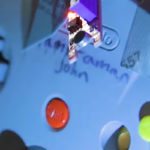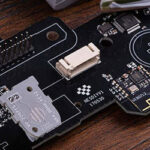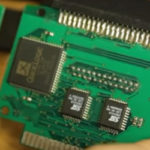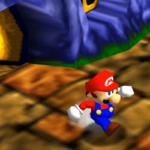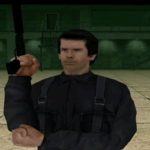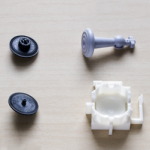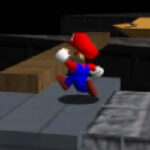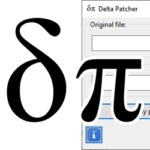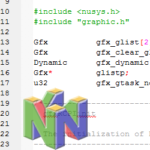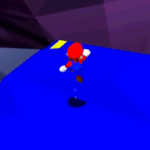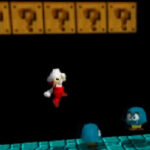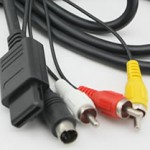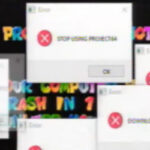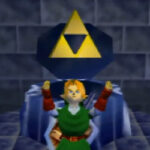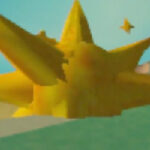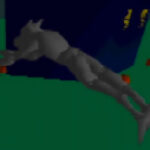N64 Rocket Launch Controller

It’s hard to belive that I didn’t come across this earlier, since this is a video that came out after I started this website. It’s a bit of a strange mod compared to the others that I’ve shown around here, but an interesting one nonetheless. Here3 is the Rocket Launch Controller for the N64. Well, not really for the N64, but you get the gist.
Here we go!
Le’s start this project with an n64 game controller. I chose yellow because this way it will match the Randomizer Rocket that I’ll show how to build in another project video. Keep an eye out for that.
Now if you flip the controller over, you’ll see that there are nine screws holding the two halves together, and all it takes to remove them is a small Phillips head screwdriver. Make sure you save the screws in a really safe place because we will need them to put the controller back together at the end. With the screws removed, let’s separate the two halves and take a peek inside.
You can see the upper half is the more complicated side, where all the buttons and electronics are. So let’s just leave that alone for a second and work on the bottom half instead. Grab a pair of pliers and look for the plastic support where the A button goes, then grip it firmly and tear it off, because we don’t need it. While we’re here, let’s rip the top off the housing where the controller paks as well. It’ll all make sense in just a second. Now it’s helpful to file and grind down the little ridges on the inner walls on the slot and clean up the rough edges where any plastic got removed. It’ll take a bit of work, but when all the walls are relatively flat and you smooth off a lot of the rough edges, you’ll find that you can push two 9-volt batteries inside and they fit perfectly. That means we can make an improvised power pak to keep the whole system portable and self-contained.
Ok, we’re finished with the bottom half of the controller for now, let’s move over to the top side. Go ahead and rip the circuitboard right out of the casing but make sure you keep all the buttons in a safe place so you don’t have to waste time looking for them later. I removed the three small screws that hold the thumbstick assembly to the casing and as you can see, the whole thing just pops out in one piece. Before we start modifying this unit, there are a few quick adjustments that need to be made to the underside of the casing. Like breaking off the plastic ridge right above the start button area and tearing off the support walls where the A button used to be. This’ll free up some space fr a few new components. Now we also need to drill a couple holes through the top so I’m using a 15/64″ drill bit to cut a hole in the center of where the Nintendo logo would normally be and a 3/32″ bit to cut a sound hole below that. At this point the upper casing is completely finished so let’s get back to modifying the thumbstick assembly.
Only one screw holds the assembly together, but you need to extremely careful when removing it because the whole casing is spring-loaded so it’ll try to burst open on you. It’ll be a lot easier if you don’t let that happen. The bottom part of the assembly is where the trigger button used to be and our goal here is to replace it with a momentary push button switch. Of course, that means we’ll have to cut a space for it. I tried using a 5/16″ bit to carve a channel halfway through the casing which apparently keeps the brackets for the circuit board intact while creating just enough room to accommodate the button on the inside. now if we dig up the original Z-button circuit board and cut a 5/16″ hole straight into the contact pad, we should end up with a hole the right side for our switch. I found this momentary switch in packs of 4 at a local electronics shop. We don’t need the cap or the little tip at the end, so go ahead and snap it off with a pair of pliers.
Flip the switch over and solder insulated copper wires to each of the terminals for durability and good electrical contact. When the solder cools, you can see that connecting the button to the circuit board is as simple as pushing it though from the underside then tightening the washer and hex nut securely on the top. With the circuitboard locked back in place, You should be able to see how this new trigger button mimics the old Z-Button almost perfectly. Let’s go ahead and replace the joystick components so we can reattach the spring-loaded assembly and screw it all back together. With that, the modified assembly is finished, so it can go back into place on the control cover and we can replace the three screws that hold it in position.
Now before you do anything else, it’s a good idea to put the control casing back together and make sure that the new switch aligns with the trigger button. I hooked mine to a multimeter to be extra sure and tested electrical continutiy each time the button was pressed. It seems like everything is working perfectly so that means it’s time to load the controller with a few more goodies. You’ll see what all these do in just a minute. I found a red push button that’s an awesome replacement for the old A button. This is going to become the ignition switch for the actual rocket launch. It’s got a plastic nut hold it from the backside, which keeps it tight and prevents it from popping back out.
The next step is attaching the buzzer and a green LED. I found that a ring of hot glue around the center hole is all it takes to hold the buzzer right where we need it. And of course it works best if you can line the center up with the small sound hole we made earlier. Now you should find that the sub miniature green LED makes an excellent fit with the other hole we made at the top. and this one will need to be held with hot glue as well because there’s no room for the hex nut. Just use a liberal amount of hot glue and when it cools, that LED won’t be going anywhere.
At this point, all the major components are installed so let’s solder them together and bring this launch controller to life. I cut up the cord from an old cell phone charger and wired everything together using this schematic. I designed the circuit to run on two 9V batteries in parallel so it has a higher current. The LED and buzzer are set in parallel as well, but will only work if the button on the trigger is pressed. When the trigger is pulled, a very small electrical current will pass through the igniter to check whether it’s intact or whether it’s damaged. If the connection is good, then the current continues to flow through the circuit lighting up the LED and sounding the warning buzzer letting you know that the igniter has continuity and is ready for ignition.
Now even though electricity is flowing, it’s only around 40mA and that’s not near enough to set off the igniter. It actually needs closer to 2A or 50 times more power for proper ignition. If you’re ready to launch, keep the trigger pulled and push the red button simultaneously. This opens the electrical floodgates and sends a surge of around 6A through the igniter, firing it off instantly.
All right, now that the connection points are soldered and insulated with electrical tape, we just got a few finishing touches left. Find the circuit board you ripped out earlier and draw two lines. One on the bottom side of the controller pak connection, and another that humps up over the contact pad for the A button. We can make things a little more tidy by ripping all the wires and coreds off the board And if we use a large pair of pliers to grip the slot for the controller pak and give it a good twist, it’ll snap right off. Now carefully break off pieces of the board around the A button then grind down any rough edges with a file to clean it up and make it look a bit nicer. Find the silicone button pad next with the 6 contacts on it and use a marker to draw out a line separating where the A button would be and simply use a pair of scissors to cut it off and that’s it. We can go ahead and gather up all the buttons now, and put the whole thing back together. When the components are back in place, go ahead and lay the modified button pad in position. Now it should make sense why we had to make that cut.
The circuit board goes in next to help keep the buttons from falling out and to make sure they look and act like normal. Now before we screw the casing together, there’s just one thing left to do. And that’s to add 30′ lead wires so we an ignite the rockets from a distance. And for that, I’m using a 100′ roll of 24-gauge speaker wire I found at the hardware store. I soldered and taped the wires into position, then tied a knot to the inside of the casing to protect the wire from being pulled out accidentally.
At this point, let’s feed the two 9V battery clips through the slot for the Controller Pak and screw the two halves back together. Just like that, our N64 rocket launch controller is completely finished and ready for testing. I hooked up two 9V batteries and pushed them into place, and gathered up a handful of my homemade rocket igniters, which you can learn how to make in another project video. Just for convenience, I attached alligator clips on the ends of each wire so the leads will bite on to the igniters. This way we can hook up and even change igniters within a matter of seconds.
Now if the electric match has continuity, then when we press the trigger, a green light and buzzer will come on telling us the system is armed and ready for launch. And pressing the red button next will light it up. And of course, 30′ lead wire means we can remotely launch our rockets now from a pretty good distance away. I took this launch controller out into the desert to test on homemade rockets and sugar motors that I showed you how to make in another project video.
You can see that with everything connected properly, the controller worked exactly how we hoped it would, so we don’t have to worry about lighting a fuse and running away anymore because instead now we have the ability to launch rockets or even light pyrotechnics with a simple push of a button. Well now you know how to convert an old video game into a remote controlled rocket launch controller that not only looks awesome, but launches freaking rockets in real life. By the way, if you’re wondering what to do with the left over cord from the controller, don’t throw it away. Instead, use it to mass produce another round of igniters for future launches.
Now let’s have a look at the mod itself. When I found this mod, I went through a whole bunch of videos by King of Random regarding his DIY rocketry (highly recommended) and it was a blast. However, looking back on this one about the N64 rocket launch controller in particular he didn’t really do much to the mechanism itself. It’s the same old shell as the controller, just that the whole thing is broken apart inside and two buttons are put in its stead. Really, he could have just put the two buttons on a slab of word and it would have worked just as good.
I think that it would have been much cooler if the controller had some kind of other use than just a case for the two buttons. Of course, that would have made the whole project a lot more difficult though. For example, a series of transistors could create a logic circuit to allow the rocket to launch only if a certain ‘cheat code’ has been entered. Ie, hold down the L, C-up, B and Start buttons in order to make it work. It could also have enabled the joystick to do something other than just take space, like use the tilt to slowly increase the heat in the ignition coil.
One thing I found kind of funny with this project is that he used a bootleg N64 controller. You can tell because the joystick has only two cables coming out of it, and the logo is missing from the front face. This is why I mentioned using the joystick to control the heat , since they use potentiometers rather than light sensors like the originals had. At least he didn’t destroy one of the (increasingly rare) original controllers.
Don’t get me wrong, it’s still an original idea. I’d love to see a, N64 controller re-purposed to more uses in the future.
